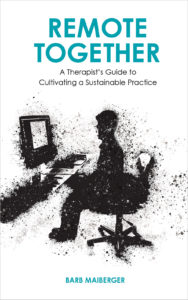
In recent consultation sessions, more and more EMDR therapists have been asking: how do I do remote EMDR therapy? For some therapists and clients, the transition from in-person sessions in an office to remote EMDR therapy sessions from their homes can feel as natural as breathing, while for others it can feel like asking someone to transform their home into a virtual-bed-and-breakfast-homeschooling-coworking-space overnight.
In listening to their stories, what I’m hearing more often from mental health colleagues is that their hearts are hurting, and so are the hearts of many of their clients. Many therapists and clients are heartbroken, and grieving the loss of the safety, connection, and comfort they built together in the therapy office. This hurt, this somatic pain of disconnection, can be felt sometimes whenever clients and therapists are unable to connect as usual due to a natural disaster, economic crisis, a life-threatening event, or a pandemic. What I’m hearing is trauma, the other sickness that spreads during a pandemic. Trauma is spreading, in both therapists and clients, probably faster than any virus right now.
As fellow therapists and consultants struggle to find answers, I found myself reaching out to other therapists, consultants, and even remote therapy startups for guidance, and wanted to share with all of you what I am finding, so that we can all resource each other through these challenging times together, for it takes a community to resource a community.
I’ve condensed what I’ve learned into what I call the 8 Phases of Remote EMDR Therapy.
I hope these resources will support you and your practice.
Phase 1: Safety First
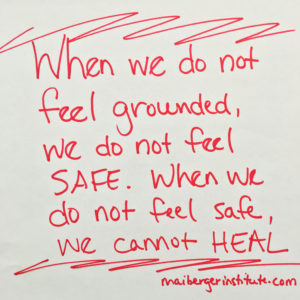 Times are changing rapidly at a speed that can be difficult to keep up with. Therapists and clients are now having to switch to remote therapy, and this is a big transition for both of them. Not being able to be in the safety of the office can be ungrounding. When we do not feel grounded, we do not feel safe. When we do not feel safe, we cannot heal.
Times are changing rapidly at a speed that can be difficult to keep up with. Therapists and clients are now having to switch to remote therapy, and this is a big transition for both of them. Not being able to be in the safety of the office can be ungrounding. When we do not feel grounded, we do not feel safe. When we do not feel safe, we cannot heal.
It can be traumatizing if our basic physiological needs, our need for safety, and our need for love and belonging are under constant and persistent threat. This sense of fear, scarcity, and disconnection is being felt by many therapists and clients. It’s difficult to get the rational part of the brain to lead the way towards learning new things when the most basic of needs are not met. Both therapists and clients can become reluctant in trying new ways of continuing their therapy sessions when both of them are in a state of fear, a state of trauma. It’s challenging to think about what kind of remote therapy technology you should use, when you are in a fear state and all your amygdala can think about is, “Did I buy enough toilet paper? How will I put food on the table? Will I get sick?”
In this sense, many of us have ruptures in the first through third levels of Maslow’s Hierarchy of Needs:
- First Level: Physiological Needs (air, water, food, shelter, clothing, reproduction)
- Second Level: Safety Needs (personal security, employment, resources, health, property)
- Third Level: Love and Belonging (friendships, intimacy, family, sense of connection)
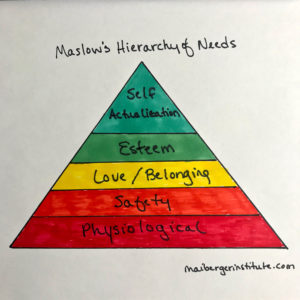
The first level is about physiological needs including the air we breathe, the water we drink, having enough food to eat, and a shelter to live in. During a pandemic, our homes might feel stressful, going to the grocery store might feel dangerous, and it can even feel like the air we breathe might harm us. Although many may be convinced hoarding and panic buying might be logical or rational in a time of crisis, such responses often operate from a fear state in the brain as a reaction to the fear of scarcity, a pure sense of survival. One cannot be both prepared and panic at the same time. If you are panicking, by definition, you are not prepared.
The second level is a big one: safety. How safe are you feeling right now? Do you feel safe working in your office? Do you feel safe working from home? Do you feel safe to be in a group? Do you feel safe to run errands? Do you feel safe to touch doorknobs or handles? Are you missing a simple hug or handshake? How safe are your clients feeling?
For many the sense of safety in our homes, jobs and our daily routines have been ruptured, interrupted, or disrupted, which can be traumatic. Our sense of safety in the world does not match what we had a month ago, a week ago, maybe even a day ago. For some, the home is already not a safe place. For others, what once was a tranquil safe place has now become a homeschool, a virtual office, or even a quarantine zone. The world as we have known it, doesn’t exist right now. And because of that lack of safety and familiarity, people are living in a state of fear.
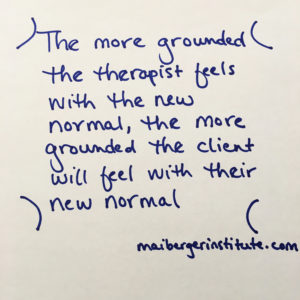
The third level relates to the human need for love and belonging. Humans by nature are social creatures. We need to belong to community and feel love and connection. When we are not able to connect with people in the usual ways that we do on a daily basis, social distancing can sometimes feel like social isolation. We are social creatures from moment one. Connection, love, touch, community are basic human needs. Babies literally need to be touched in order to thrive, and so do adults.
Many of us have lost our sense of safety in the world. As I am consulting with therapists, what I am recognizing is that they are feeling ungrounded in their own bodies. Social distancing is pushing therapists out of their offices and into their homes to offer therapy. Therapists are used to making their office space a safe place for their clients to feel and express what is troubling them in their lives, and to work through their trauma. The transition to remote therapy can be difficult for many therapists and for many clients as well, who have both gotten used to the familiarity and safety of the therapy office.
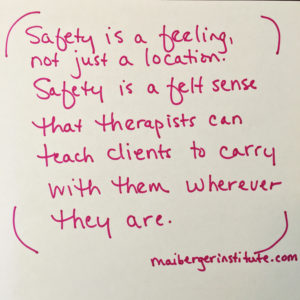
Before a therapist can introduce new techniques or technology to their clients, therapists first need to ground themselves, and manage their fears as they try to continue therapy with their clients, whether online or otherwise. The role of a therapist is to model for the client how to be grounded, connected, and feel safe anywhere, not just in the office. The more grounded the therapist feels with the new normal, the more grounded the client will feel with their new normal.
Remember the fundamentals you learned in your EMDR training, think back to the psychology basics you learned in college, and think about the skills and tools you’ve learned and accumulated about safety, containment, resourcing and grounding. Remind yourself and your clients that safety is a feeling, not just a location. Safety is a felt sense that therapists can teach clients to carry with them wherever they are.
Phase 2: Practice Fundamentals
Whether you are an EMDR therapist or otherwise, you are first and foremost a therapist. Even during a crisis, the fundamentals of therapy are the same: safety, trust, and privacy. At the same time, the world of psychotherapy has to adapt to meet the growing needs of their communities. With this in mind, EMDR International Association (EMDRIA) recently outlined some fundamental guidelines to prepare EMDR therapists to practice EMDR therapy remotely. As you read guidelines such as these, ask yourself the following questions:
- Do you have an “Informed Consent for Remote EMDR Therapy” form?
- Does your state licensure board allow for practice of remote psychotherapy?
- Does your license allow you to provide therapy for a client in different state, remotely or otherwise?
- Whether online, phone, or text, are you using a HIPAA a compliant Platform to conduct remote EMDR therapy?
- Does your malpractice insurance allow for remote therapy?
- Do your insurance panels accept remote therapy?
- Are your client files as secure in your home office as they are in your therapy office?
Both EMDRIA and the EMDR Research Foundation state that while we have evidence for the efficacy and effectiveness of in-person EMDR therapy, we do not at this time have enough research on how remote EMDR therapy compares to in-person EMDR therapy. At the same time, there is research around the efficacy and effectiveness of teletherapy, and there is no research to say remote EMDR therapy does not work. Which opens opportunities for new research through EMDR Research Foundation grants to study the impact and effectiveness of remote EMDR therapy. Until then, let’s be open to meeting the needs of this brave new world, and encourage each other to explore and share what we are learning about remote EMDR therapy.
Here are some additional guidelines that may also help as you research and explore remote EMDR therapy options:
- American Psychology Association Guidelines for the Practice of Telepsychology
- American Psychiatry Association Telepsychiatry Practice Guidelines
- US Department of Health and Human Services
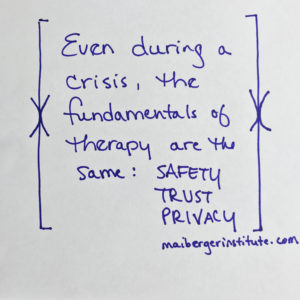
I also wanted to provide a list of what are considered HIPAA compliant remote therapy platforms and tools that are currently available to therapists. Many of these businesses also offer free trials. Please note that — other than Zoom, GoToMeeting and Adobe Sign — we have not tested any of these tools, nor is this list necessarily an endorsement of said tools:
All-in-One Remote Therapy Platforms
Remote Conferencing Platforms
Digital Document Signature Tools (for intake forms)
Whether it’s called remote therapy, telepsychology, teletherapy, virtual therapy, tele-mental-health, or even text therapy, be mindful when choosing any new remote therapy tool of any updates to HIPAA regulations, especially in your state (see resources at the end of this blog). Although HIPAA regulations may change during times of crisis, in the long run, it is may be best practice to invest in a remote therapy platform that will remain HIPAA compliant even if there is no crisis.
Once you feel ready, be sure to let your clients know you offer remote EMDR therapy on your website, your online profiles, and announce it on your social posts. Let your clients know there are still ways to stay connected.
Phase 3: Therapist Preparation
One of the fundamentals of being an EMDR therapist is that we must first prepare our clients to do trauma work. In that same sense, therapists must prepare themselves to do remote EMDR therapy before offering it to their clients. Preparing yourself to do remote EMDR therapy may take some practice, so practice.
When you are not feeling secure in a new space or with new technology, take time to use the very same resources and skills that you teach to clients. Take time for yourself to find safety in your own body. That means grounding yourself before a session. That means finding the resources and allies to help you contain your own fears, doubts, anxiety about your own life as you experience uncertainty in this new world. Remember the fundamentals, essential, everyday skills of being a therapist.
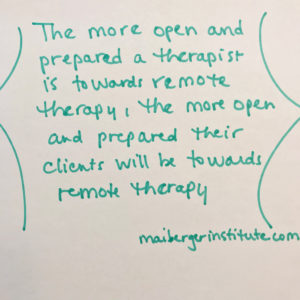
First you need to make sure that you are able to establish privacy and quiet during your remote EMDR therapy sessions, especially from other people (and pets) in or near your home. Just as you are mindful of the objects in your office, be mindful of what is visible to the client in the background of your home office and near your computer. Is there something from your office that you can have in your home office, like an office plant or artwork, that could remind both you and your client of the therapy office?
You should also be just as thoughtful in what you wear during your remote therapy sessions as you would be if you had to walk into your therapy office. Be professional; don’t wear your pajamas to your sessions with a litter of kittens in your lap.
Find ways to create a new safe place for each other to continue to do the important work that needs to be done. Transitioning to remote therapy is not about re-creating the same office space; it’s about re-establishing the felt sense of the safety and connection that you and your clients once forged and shared together, just in a different place in a different way.
The more open and prepared a therapist is towards remote therapy, the more open and prepared their clients will be towards remote therapy. Being prepared and having worked out all the kinks and glitches can provide safety for the client, that they can be confident you know what you are doing. Here are some tips to think about as you explore technology options for remote EMDR therapy:
- Become familiar with your choice of technology first so that you aren’t trying to figure it out on the fly with a client.
- Test your technology with your friend/family before trying it out on your clients. d
- Be mindful that some videoconferencing tools publicly post the names of participants of the session (some even share your data with other vendors); be sure to have this function turned off for privacy, or just use another service that doesn’t post participant names.
- If you are using an online service, try to have your computer connected directly to your secured router/modem rather than using WiFi. Advise your client to do the same. Having other devices in airplane mode or turns off can also help with reception.
- Have a back-up plan if the technology freezes or shuts down.
- If you are using video, both therapist and client should try to position themselves farther away from the camera than usual so you can both see more of each other than just your faces. Allowing both of your bodies to move and be free will be important so you can both see and feel more of each other’s presence.
- Be mindful that not everyone has a computer, not everyone has broadband, not everyone uses the same web browser, not everyone has a private spare room, and not everyone can hear, speak, see, move, or learn like you. Get to know your clients again with this in mind as you and your clients explore remote EMDR therapy options.
Know that I too have struggled to transitioning from analog tools to digital tools over the years. For example, I loved, loved, loved my Day-Timer calendar, and it took over a year for me to transition to an online version. Now, I can’t imagine not having my online calendar at the tip of my fingers. It also took me a long time to switch my consultation practice over to virtual methods; it just felt like too big of a leap for me. Now, I am able to reach more people across the US, so that I can support more therapist in their journey of practicing EMDR therapy. It took years of practice, patience, and persistence in finding my own way into becoming as proficient and adept at using the online tools I use today. I have faith you will find your way as well. And when you are ready, when you feel prepared, you’ll be able to move onto helping your clients prepare for the work ahead.
Phase 4: Client Preparation
Think back to your EMDR Training, and recall what you learned about how to introduce EMDR therapy to your clients. Now apply the same thing to preparing your clients for remote EMDR therapy. Discuss with your client beforehand how remote EMDR therapy will work, empower your clients with the resources and tools they need to conduct remote EMDR therapy, set expectations, share your plan of what to do if something doesn’t go as planned, and rebuild the connection you once shared together.

Make sure the client has expressed their concerns with you about remote therapy. Even though we don’t have evidence to support the efficacy of this kind of therapy, at the end of the day, the protocol is the protocol, whether EMDR therapy is done in-person or remotely. We have to move forward and find ways to make this okay for the clients while still honoring the protocols. It’s better to have remote therapy than nothing at all! Finding creative solutions for your clients may be challenging and difficult, but not necessarily impossible. Be open to the possibilities rather than stuck in the impossibilities, and the solutions will present themselves. There is always a way.
As clients experience high levels of stress, anxiety, and fear of the unknown due to the abrupt changes in their work and living spaces, many clients might be out of their Window of Tolerance right now. Assessing the distress level in a client is essential to developing your treatment plan for EMDR therapy, whether remotely or otherwise. Collaborate with your clients on how to create space that is private and safe enough for them to do remote therapy successfully. Make sure this safety piece in place before going into sensitive material. For example, a therapist consulted with me the other day where the client has roommates and they are in an open loft situation. This will take some brainstorming with the client to figure out how they can be alone and feel secure enough that they can be vulnerable in a remote therapy session.
Look at what the client will need to make their session go smoother. Do they need a box of tissues near them, will they need water, grounding objects, blankets, pillows? Find out what they need that makes them feel safe and grounded in their own space. Sometimes holding rocks can be powerful for grounding tools. You can also help them create a Sensory Toolkit which they can use to help them be more present and grounded. You can find how to create a Sensory Toolkit in “EMDR Therapy and Somatic Psychology: Interventions to Enhance Trauma Treatment”. Remember that the client needs to build safety in their environment, and this is a conversation to have with them to help them figure this out.
Through all of this you are helping to build rapport with the client. Don’t worry about how many sessions this will take. Give your clients the time and space they needs to develop these resources, and then your work will be more successful with them.
Phase 5: Resourcing Your Client
When clients are dysregulated and disoriented due to their lives being disrupted go back to the basics of EMDR therapy: Safe Place and Containment. Now more than ever, EMDR therapists need to teach their clients to use these essential EMDR therapy skills to help clients re-orient themselves to the present moment, and to embody a sense of groundedness. Regulating and resourcing clients will help them feel more in control of something that feels so out of control.
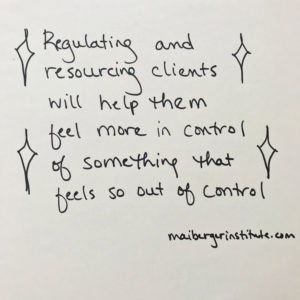 Begin to get to know your client just like you always do, and then start resourcing them as quickly as possible. That means using Resource Developmental Installations (RDI). Clients can always benefit from RDI’s whether they are in your office, or their homes. When clients are in survival mode (…am I safe? …do I have enough food? …will I be able to pay my bills?) it is a good idea to resource and provide safety to your clients by using RDI’s to ground them in their bodies. Resource your clients before introducing trauma reprocessing, especially remotely.
Begin to get to know your client just like you always do, and then start resourcing them as quickly as possible. That means using Resource Developmental Installations (RDI). Clients can always benefit from RDI’s whether they are in your office, or their homes. When clients are in survival mode (…am I safe? …do I have enough food? …will I be able to pay my bills?) it is a good idea to resource and provide safety to your clients by using RDI’s to ground them in their bodies. Resource your clients before introducing trauma reprocessing, especially remotely.
In our book “EMDR Therapy and Somatic Psychology: Interventions to Enhance Trauma Treatment,” Dr. Arielle Schwartz and I share several interventions throughout the book to help you resource and work with your clients somatically. These easy to use scripts will help you successfully implement how to incorporate the body more consciously into your practice. You must build affect tolerance before proceeding to Phases 3 – 7 of EMDR therapy no matter how many sessions you need to spend in this phase. Besides these scripts, think about other grounding tools and resources you already know.
Phase 6: Remote Bilateral Dual Attention Stimulation (BLS)
Whether EMDR therapy is done online or in-person, the protocol is the protocol. The one aspect of EMDR Therapy that can be challenging is the application of Bilateral Dual Attention Stimulation (BLS). I think the important thing to remember is to be client-centered and find what works best for your client.
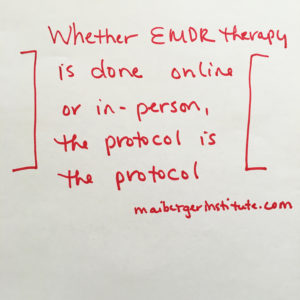 As EMDR therapists, we know that eye-movement has been found to be the most effective type of BLS when doing EMDR therapy reprocessing. I personally have found that eye-movement is a little tricky when working on a computer screen. There is a lag time with the back and forth movements, so using your hand-movement to accomplish this action can look glitchy. One option you can use for eye-movement is to have the client set an object at each side of their computer so that their eyes can move back and forth as you watch them.
As EMDR therapists, we know that eye-movement has been found to be the most effective type of BLS when doing EMDR therapy reprocessing. I personally have found that eye-movement is a little tricky when working on a computer screen. There is a lag time with the back and forth movements, so using your hand-movement to accomplish this action can look glitchy. One option you can use for eye-movement is to have the client set an object at each side of their computer so that their eyes can move back and forth as you watch them.
I think the easiest option is to have your clients do BLS by self-tapping. Self-tapping can be done on the knees or the Butterfly Hug. The Butterfly Hug can be done with the client squeezing their arms with their alternating hands for more grounding if needed.
Some therapists are saying that some of their clients struggle with self-tapping. For some, the coordination of trying to maintain dual awareness while self-tapping can feel as difficult as trying to rub their head and belly at the same time while running backwards blindfolded. Alternatives might include the client using alternating feet taps, or have the client hold soft objects in each of their hands and squeeze them back and forth. Be creative and find a solution together.
If you are looking for music and sounds that go back and forth bilaterally, we’ve selected the following resources for you to try and share with your clients.
- Spotify: We’ve created Spotify playlists of bilateral music and sounds you can share with your clients. Be mindful of ads.
- Amazon Music: This collection of bilateral music and sounds are free for Amazon Prime Members.
- YouTube: We’ve created YouTube playlists of bilateral music and sounds you can share with your clients. Be mindful of ads.
If your client prefers audio BLS, It is recommended that the client have their own headset and a device separate from the one they are using for the remote session. For example, since the remote session is over a computer, the client may need a separate mobile device to listen to the bilateral-audio. Clients will also need their own accounts for some of these resources, and, in some cases, clients may need paid/premium accounts, or purchase/download the files in order to skip ads.
During reprocessing, at the end of a set of BLS, the client can remove the headset to check in with you what they are noticing. When applying BLS using music or sounds to reprocess trauma, the client’s attention should be on the felt sense of their experience rather than focusing on the music or sounds.
Phase 7: Trauma Reprocessing
Now the big question is, “Can I do trauma reprocessing with my clients remotely?” Perhaps the more important question is, “Is my client ready for trauma reprocessing?”
- Does your client have the affect tolerance to do the trauma work?
- Can your client feel a feeling and stay present in their bodies long enough that you can do a set of BLS?
- Can your client keep dual awareness while you add BLS?
- Can your client do state change?
- Have you done enough resourcing that you feel confident that your client can handle the reprocessing of the trauma and remain safe?
Would you be doing reprocessing if the client was in your office given these answers? If not, then you already know that you wouldn’t begin reprocessing through a remote therapy session. Be mindful of the choices you are making, whether remotely or in-person.
One of the biggest concerns that EMDRIA stated in their guidelines was the fear of clients dissociating during remote EMDR therapy sessions. You can screen for dissociation by using the DES Scale – Dissociative Experiences Scale (Bernstein & Putnam, 1986). Remember, you can always slow down the reprocessing with pendulation interventions. You can find pendulation interventions in “EMDR Therapy and Somatic Psychology” book. They can be used in the Preparation phase but also in Desensitization phase. Check in with your clients more often to help the client have one foot in the past and while having one foot in the present. Many therapists are successfully using EMDR Therapy remotely, so just be smart about how you are applying it.
Another aspect of remote EMDR therapy that seems to be a concern for therapists is that it is harder to track subtle somatic cues during reprocessing and that the session can feel more impersonal. I have found that there are two parts to successfully navigating working remotely.
- Observe your client’s cues as best as you can
- Observe your own body and the somatic cues you are experiencing
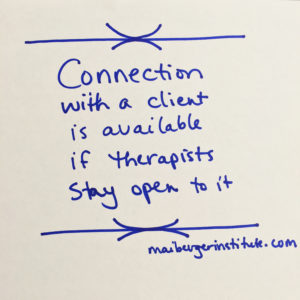
Let’s look at the clients cues first. As you develop your ability to “see” the client, I invite you to watch for subtle cues:
- changes in tone of voice changes or the cadence of the speech
- changes in their body posture changes,
- looking away from you or maybe staring at you,
- repetitive movements such as biting their nails, or twirling their hair over and over
- the monitor may be bouncing due to their shaking of knees
- notice how their breathing shifts
- notice the onset of pain in the body or nausea.
All of these are clues to pay attention to. Using your attunement statements while reprocessing such as: “that’s it, keep going, uh – uh, trust the process” can help the client keep dual awareness and in the window of tolerance. If you aren’t witnessing a lot of somatic cues, check in with the client more often and make sure that the reprocessing is working. Ultimately, I think it’s important to trust your gut: if something feels wrong, take action immediately.
The second part is to listen to your own body’s somatic cues. Your body is an instrument that when listened to, can guide you in what is happening in the session. You have to listen on a deeper level and not just rely on your eyes to “see” what is happening in sessions. Practicing daily mindfulness can help you get to know your own body so you can use your body to signal you that something is wrong. Somatic transference can be powerful in EMDR therapy even if you have a computer screen between you.
Therapists can still experience these strong interactions through a computer screen, and still be a psychobiological regulator for their client, even if they are not physically in the same space. Connection with a client is available if therapists stay open to it. Put these essential pieces in place and then you can safely go forward.
Phase 8: Somatic Self-Care
Something that I haven’t heard anyone addressing yet around remote EMDR therapy is taking care of your eyes to prevent eye strain. I have already been hearing complaints from therapists that their eyes are sore and hurting along with headaches at the end of the day. Most therapists are not used to being on a computer eight hours a day!
Over the years, I have found that my work has become more remote for consultation so that I can work with more therapists around the country. The longer I was sitting in front of my computer, the more my eyes became dry, burned, itchy, hurt and sometimes led to headaches even severe migraines. I didn’t know that looking at a computer all day could hurt my eyes, but it can.
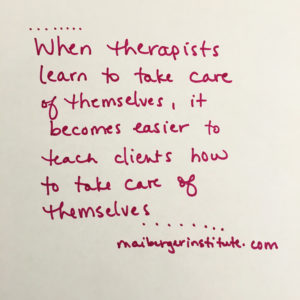 I want to share some of the things I do to take care of my eyes. Through the guidance of my eye doctor, I have found that the following things have been helpful in keeping my eyes moist and less irritated. These are not guidelines for you, rather just ideas of how to work with eye strain from long days in front of a computer. My eyes thank me daily for this attention!
I want to share some of the things I do to take care of my eyes. Through the guidance of my eye doctor, I have found that the following things have been helpful in keeping my eyes moist and less irritated. These are not guidelines for you, rather just ideas of how to work with eye strain from long days in front of a computer. My eyes thank me daily for this attention!
One of the first things invested in was a pair of “Blue Blockers” glasses. These glasses are meant to help block blue-light that emanates from computer screens. From my understanding, the blue light that emanates from the computer screen can lead to digital eye strain and eventually can lead to vision problems over time. Not everyone agrees that they can be helpful, but I have found that wearing them puts less strain on my eyes.
I also try to remember to blink more often. It is normal to blink 15 – 20 times per minute to moisten and lubricate our eyes. Studies are showing that people blink half that amount when looking at phones, pads, and computer screens. This means that eyes start drying out which can cause irritation. The simple act of remembering to blink is not easy but can make a huge difference in the long run in helping your eyes feel better. I have also found that using homeopathic eye drops have helped moisten my eyes and keep them better lubricated throughout the day.
I have also find “eye palming” to be soothing for my eyes. Simply rub your hands together creating some heat. Once you feel the heat, softly place your palms over your eyes. Let the warmth soak into your eyes, letting your eyes bathe in this soothing sensation. As you feel the warmth, check in with your breathing and make sure you are taking long, calming inhales and exhales. Once the heat dissolves, you can release your hands.
One of my favorite things to do at the end of the day is to use an eye compress, hot or cold, to soothe my eyes. I wet the washcloth and put it over my eyes while laying down to rest. If you try this, notice your breathing and make sure that you are doing a calming breath to help you relax. I do this for around 15 minutes before moving on with my day.
My eyes are just one example of the somatic strain the transition from my office to a remote setting has had on me. I am hearing from many other therapists similar types of somatic strain. Some have reported neck pain, shoulder pain, back pain, pain in their fingers or wrists, feet going number, headaches, or feeling drowsy.
For example, if you wear ear buds or headphones, be mindful that your ears are being taken care of as well. The heavy use of ear buds or headphones may cause irritation in the ears, and even sometimes disorientation after taking them off after sitting for long hours. You may even feel phantom ear syndrome where even when you take them off, it feels as if they are still in your ears.
Remember to take breaks from the computer. After each session, get up, stretch, move around the room, stay hydrated. Take care of yourself. For more tips on somatic self-care for EMDR therapy, review Chapter 8, “Tools for Therapist Self-Care” in the book “EMDR Therapy and Somatic Psychology.” Therapists must embody somatic self-care before, during, and after every session.
I also invite you to share some of these somatic self-care tips with your clients as well, as they too may be feeling some of these somatic strains. When therapists learn to take care of themselves, it becomes easier to teach clients how to take care of themselves.
Reflection
I hope these 8 Phases of Remote EMDR therapy will help you set in motion safe practices in your work, to stay connected with your clients, and to be a resource for your communities.
Just as medical professionals, emergency services providers, and public health officials are vital in stopping the spread of viruses, diseases, and disinformation, therapists in our communities, counselors and mental health professionals play a vital role in stopping the spread of fear, anxiety and trauma in our communities. Now more than ever clients need their therapists. Now is the time for therapists and clients to find creative solutions to stay connected. Now is the best time for therapists to lean into the important role they play in resourcing their communities, and it is always now.

Remember that you are not alone in this. Remember that as an EMDR therapist that you are part of a larger community of therapists who are going through the same thing as you are. Remember this is going to be a marathon not a sprint, so look for long term solutions that will ground you and your practice over time.
If you are struggling, find the courage to reach out for help, to get support. I recommend finding consultation groups and support from other therapists in guiding you through this process. I would also encourage you to share what you’ve learned of what is working for you and your clients with your fellow therapists.
Take good care and know that you have my support!
You have all of our support.
You are not alone.
We are all in this together. 💚 #RemoteTogether
About Barb Maiberger, MA, LPC
 Barb Maiberger, MA, LPC is the founder of the Maiberger Institute, and the author of “Remote Together: A Therapist’s Guide to Cultivating a Sustainable Practice,” “EMDR Essentials: A Guide for Clients and Therapists and the co-author of “EMDR Therapy and Somatic Psychology: Interventions to Enhance Embodiment in Trauma Treatment.” Barb Maiberger is an EMDR Trainer and Consultant, and is the CE Program Administrator for the Maiberger Institute. She is a Licensed Professional Counselor in the State of Colorado and has a Masters degree in Somatic Psychology. Barb has personally conducted over a hundred EMDR Training programs. Barb’s knowledge, experience, keen sense of empathy, and a strong presence have motivated over a thousand therapists to incorporate EMDR Therapy into their practices.
Barb Maiberger, MA, LPC is the founder of the Maiberger Institute, and the author of “Remote Together: A Therapist’s Guide to Cultivating a Sustainable Practice,” “EMDR Essentials: A Guide for Clients and Therapists and the co-author of “EMDR Therapy and Somatic Psychology: Interventions to Enhance Embodiment in Trauma Treatment.” Barb Maiberger is an EMDR Trainer and Consultant, and is the CE Program Administrator for the Maiberger Institute. She is a Licensed Professional Counselor in the State of Colorado and has a Masters degree in Somatic Psychology. Barb has personally conducted over a hundred EMDR Training programs. Barb’s knowledge, experience, keen sense of empathy, and a strong presence have motivated over a thousand therapists to incorporate EMDR Therapy into their practices.
Learn More About Barb Read “Remote Together”
Remote EMDR Therapy Resources:
- Learn Remote EMDR Therapy
- Self-Care Books for Therapists
- EMDR Therapy Books
- EMDR Training Resources
- “Remote: Office Not Required” by Jason Fried and David Heinemeier Hansson
- “Remote Together: A Therapist’s Guide to Cultivating a Sustainable Practice“
- “Remote Traumatization“
- An Evaluation of EMDR Therapy Delivered Remotely During the Covid–19 Pandemic
- Colorado DORA Update Regarding Teletherapy
- Colorado General Assembly Regarding Telepsychology
- Colorado Counseling Association Regarding Teletherapy
- Other EMDR Therapy Resources
Learn EMDR Therapy to Help Heal PTSD and Trauma
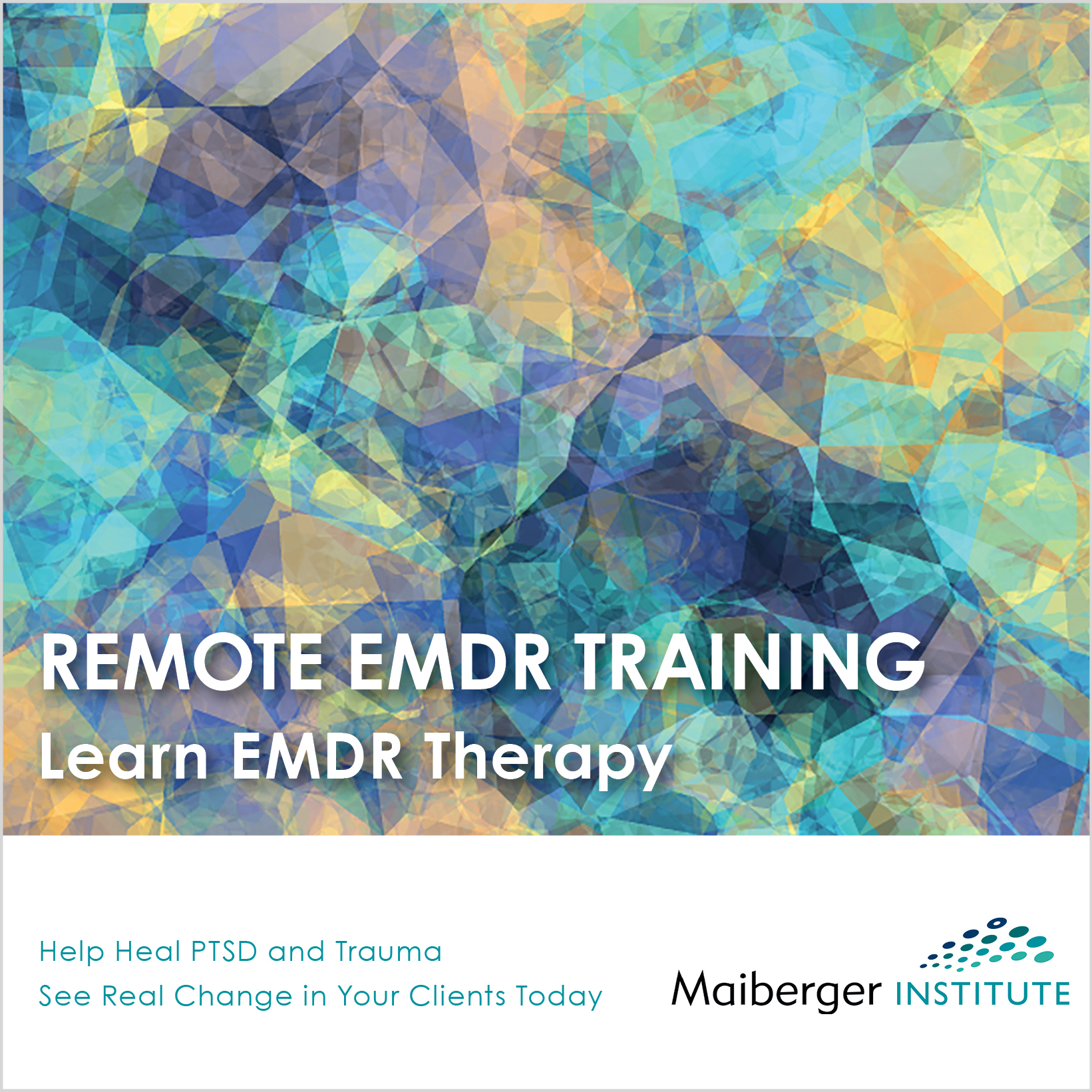 As clients struggle with not making the changes they are longing for in therapy, many therapists become frustrated and feel helpless that they are lacking the skills to help their clients make lasting change and transformation. If therapists only pay attention to what the client is saying, and the client is struggling to make lasting change, then something is missing in the therapeutic process. The solution may be a somatic approach to healing trauma using EMDR therapy.
As clients struggle with not making the changes they are longing for in therapy, many therapists become frustrated and feel helpless that they are lacking the skills to help their clients make lasting change and transformation. If therapists only pay attention to what the client is saying, and the client is struggling to make lasting change, then something is missing in the therapeutic process. The solution may be a somatic approach to healing trauma using EMDR therapy.
This evidenced based, integrative modality, is a recommended treatment of choice by several international mental health organizations for healing PTSD and trauma. Millions of people around the world have transformed the negative impact experienced from traumatic events into more adaptive ways of living by increasing their confidence, sense of joy and feeling more at peace. Real change is possible!
Learn More About Remote EMDR Training






